
By Ted Gotsch
Policy Content and Publications Manager
November 20 is National Rural Health Day. It’s a day to celebrate the vital rural health care system, and to reflect on persistent challenges that leave residents in rural communities vulnerable and the health infrastructure stressed. And it’s a good day to learn more about a new rural health program.
For years, those living and working in the medical fields in rural America have faced sizeable disparities caused in large part by an aging population and provider shortages. Rural hospitals often serve as the only medical facilities in their communities yet face financial challenges due to reduced reimbursement rates from insurers, Medicare, and Medicaid.
A significant effort to revamp the rural system emerged in July with the passage of the One Big Beautiful Bill Act (OBBBA). As part of the broad-reaching legislation, $50 billion in total was set aside over the next five years to create the Rural Health Transformation Program, which is meant to bolster health care across less populated regions of the nation.
The aim of the program is to:
- Support rural health innovations and promote preventive care;
- Ensure rural providers can become long-term access points for care by improving efficiency and sustainability;
- Build and retain a strong rural health care workforce;
- Test new models of care delivery to improve rural health outcomes and lower the cost of care; and
- Expand use of technologies that promote access and efficiency in rural settings.
Earlier this month, the Centers for Medicare & Medicaid Services (CMS) announced that every state had submitted an application to receive funding through the program where each state outlined how they intend to expand access, improve quality, and boost outcomes for patients. Half of the dollars will be distributed based on a pre-set formula among the states, while the rest will be disbursed based upon a review of proposals led by rural health experts that will be overseen by senior federal authorities. Grants will be awarded by the end of the year.
“This program moves us from a system that has too often failed rural America to one built on dignity, prevention, and sustainability,” CMS Administrator Dr. Mehmet Oz said in a statement.
There have been concerns raised about the program. It was a late add to the OBBBA after several lawmakers raised concerns about Medicaid cuts included in the legislation. KFF (formerly the Kaiser Family Foundation) notes that the $50 billion replaces a little more than a third of the of the estimated loss of federal Medicaid funding in rural areas. They also point out that the rural health program funding is temporary, while many of these Medicaid cuts will be ongoing.
Another area to watch is the funding process. KFF states that the new law grants CMS broad discretion over the distribution of funds and that decisions are not subject to administrative or judicial review. The OBBBA provides CMS the authority to determine which state applications to approve or deny, without specifying the criteria CMS should use to make these decisions. While the law does mandate certain items that states must include in their applications, there is lack of specificity around how the applications will be reviewed and considered.
The Rural Health Transformation Program will play an important role in the Trump administration’s efforts to improve rural health care during the rest of the president’s time in office. As the Academy continues to engage in public policy efforts around health care coverage and affordability, as well as addressing benefit design, measuring health and economic outcomes, and understanding the various levers that influence health care and our overall health, there is no doubt that actuarial expertise and insight will continue to be needed at the federal, state, and local levels.
As the program gets into full swing, pay attention to Academy communication channels for perspectives the profession shares on its impact and policy implications.